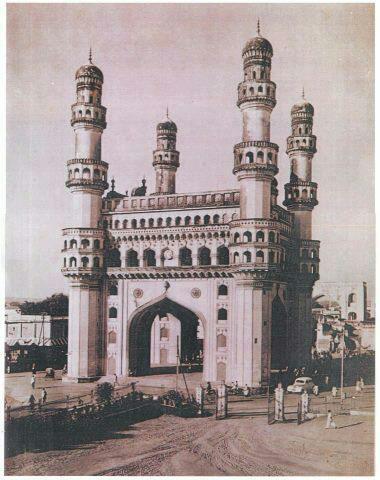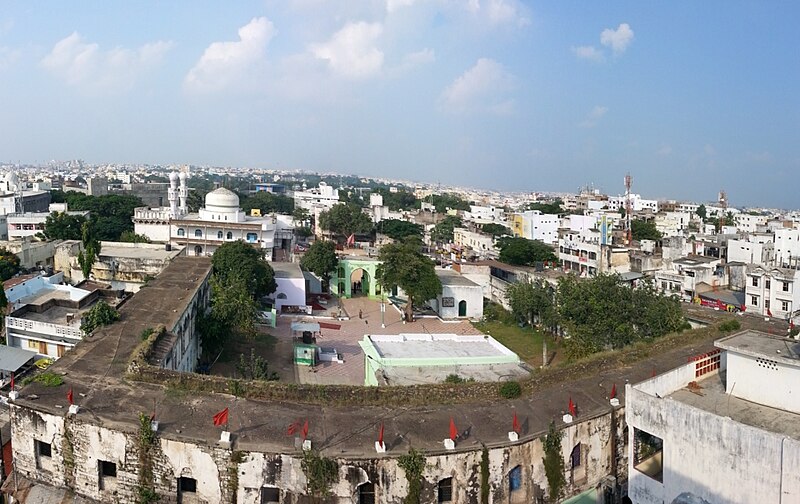Mohammad Quli Qutub Shah : founder of Hyderabad city
Mohammad Quli Qutub Shah founded the city of Hyderabad in India. It is 425 years old. A bustling metropolis, the old and the new co-exist here. One can still see the vestiges of older days and the edifices of modern times. The city has been witness to ups and downs but its charm lives on. It reflects a composite culture with different religions, communities and groups living and contributing to life here. The flora and fauna are also typical of the Deccan region with varieties of trees, flowering plants adding to the kaleidoscope. The rock-scape is millions of years old and finds mention in writings on the city, adding character and mystique to Hyderabad.
He was the third son of Sultan Ibrahim Quli Qutub Shah, born in 1565 and the fifth sultan of the Qutub Shahi dynasty who founded Hyderabad in 1591 and built the famous Charminar. The plan of the city was modelled on the Persian city Ispahan, and a ''replica of heaven''. He ascended to the throne at the young age of 15 and ruled for 31 years.
There is a beautiful love story attached to the history of Hyderabad. Many question its validity but several historians have claimed it to be true. The young prince Mohammad Quli met a girl, Bhagmati in Chichlam village who was on her way to a temple; while searching for a new place for establishment of a new city; and was captivated by her charm and beauty. He fell madly in love with her and wanted to marry her. However she was a Hindu and they faced strict opposition from the Muslims of the time. The city to be built was on the southern bank of Musi river. He is believed to have crossed the river during storm and flood to meet Bhagmati, hearing which his father Sultan Ibrahim Qutub Shah ordered for a new bridge to be built now known as Purana-pul, made in 1579.
 |
Artist representation of the meeting between Bhagmati and Mohammad Quli.
Source : http://www.deccanchronicle.com/nation/current-affairs/110916 Bhagmati has a daughter who is named Hayath Baksh. Hayath Baksh went on to be remembered as the mother of a subsequent ruler. Her tomb is a part of the Qutub Shahi tomb complex at Shaikpet at Hyderabad. However many believe that the city is named after Imam Ali whose title was Hyder. The word hyder means ''brave'' in Urdu and Persian; abaad means populated. Several travellers who came to the city have described it in their accounts. They include the French traveller Jean-Baptiste Tavernier in 1642, Thevenot in 1665-66 and Abbe Carre in 1672.
Mohammad Quli Qutub Shah was an able administrator and a great builder. He maintained good relations with Persia and there was extensive trade between Golconda and Persia. Tobacco, gun powder,rubies,textile wooden furniture were exported ; while ceramics, carpets,glass silver,pearls and horses were imported.
The Unani or Greco-Arab system of medicine flourished during this time. There was a continuous inflow of immigrants from Persia and there was Persian influence in fields of education and administration. Land revenue was the chief source of income. There existed tax on tobacco, salt,toddy etc. A tax existed on diamonds; and the diamond mines in the kingdom were given on contract and rent was collected for them.
Exports include steel products and diamonds too. Masulipatnam and Srikakulam were the main ports; Narsapur was known for ship-building and ships sailed in all directions from the ports. The famous blades of Damascus got the raw material from Nirmal and Indur, north of the city; as per historian Jadunath Sarkar.
Portrait, Mohammad Quli Qutub Shah
Public Domain, https://commons.wikimedia.org/w/index.php?curid=100407
Mohammad Quli Qutub Shah was a peaceful person and though there were border skirmishes he was not a military conqueror. His involvement with the Mughals was indirect and he managed to keep his sovereignty. He was more involved in poetry, town-planning, architecture and literature. Mohammad Quli wrote poetry in Persian and Urdu. His collection or diwan is called Kuliyat-e-Quli Qutub Shah. Below is a line from a poem composed by Mohammad Quli Qutub Shah.

Translation: The lady asks opulence, " why art thou come?"; opulence laughs and says " it is for Qutub Shah's sake that I am come from eternity"!
By Tarunpant - Own work, CC BY-SA 3.0, https://commons.wikimedia.org/w/index.php?curid=27958915
The Charminar was the earliest aesthetic monument to be built in the newly planned city. According to some it is built like a taziya or a replica of the mausoleum of Imam Hussain. While some opine it is the city centre or piazza. Made of plaster and stone it stands majestically with four tall minarets with heights of 48.7 meters. The minarets have four storeys with 146 steps; while the main building has three floors and a mosque on the western side of the roof. The mosque has 45 prayer niches and open space in front.A school is also belived to have existed on the second floor of the monument. The Charminar is symbol of the city of Hyderabad and is one of India's marvels of architecture.  Charminar, Hyderabad, built in 1591 by Sultan Mohammad Quli. By Hoodedemperor - Own work, CC BY-SA 3.0, https://commons.wikimedia.org/w/index.php?curid=22763693 The other structures include the Char Kaman or the four arches, located north to the Charminar about 75 metres away, originally called jilukhana (guard's square). At the centre of it was the char-su-ka-houz, The western arch led to the palaces. Originally called Sher-e-Ali, it got changed to Sher-e-batil with time. The eastern arch is called Kali Kaman, the northern one Machli Kaman and the southern one Charminar Kaman; though initially they did not have any names. Musicians used to play shehnai (musical instrument)five times a day on the eatern arch. The western arch led to the palace area, where there was a serai (inn) and a hospital. The palace area had an ornate and beautifully decorated gate. The doors were made of fragrant sandalwood studded with precious stones and nails of gold. A screen made of gold-cloth existed behind the doors.The palaces included the Lal Mahal, the Dad Mahal, The Jina Mahal, the Qutub Mandir and the Khudadad Mahal. Of these the Sultan stayed in the Qutub Mandir. The Dad Mahal was used for dispensing justice.Nadi Mahal with its pavillion, was at the bank of the river Musi which the Sultan used for relaxation. Servants attached to the palaces stayed at the Lal-mahal. The Khudadad Mahal had eight storeys and ws built after the marriage of Hayat Baksh Begum. Besides there was also Ala Mahal, the Koh-i-tur pavillion, the Sajan Mahal .The palaces don't exist anymore as they were destroyed during the Mughal invasion of Hyderbad. The area has the High Court building, City College etc.in present times, the 21st century. Mohammad Quli's poems have references to the palaces. Mohammad Quli built many gardens and pavillions like the Nabat Pahaad. Gardens were made in and around the city. Flowering and fruit trees abounded which made travellers mention them in their accounts. Mir Momin Astrabadi of Persia was the chief architect of the city. He was a poet too. He brought expert draftsmen and skilled craftsmen from Persia like Abu Talib,Kamal-ud-din Shirazi and Sheher Yar Jahan. The Badshahi ashurkhana is a religious building constructed in 1596 to house the alams (replicas)of the standards carried by the Prophet's grandson Hussain at Karbala. The whole place was lit up with Mohammad Quli lighting 1000 lamps everyday till the tenth day of the month of Moharram. The beautifully enamelled tiles at the Ashurkhana have inscriptions in Persian.  Badshahi ashurkhana with tile work, built in 1596, Hyderabad. By Madhu vottery - Own work, CC BY-SA 3.0, https://commons.wikimedia.org/w/index.php?curid=30298316 Jama Masjid was built during the reign of Mohammad Quli, the second mosque in the newly founded city. I has a side entrance, and originally having a school teaching Arabic, a monastery and a bath attached.  Darulshifa area in Hyderabad. By Hadisaab (Own work) [CC BY-SA 3.0 (http://creativecommons.org/licenses/by-sa/3.0)], via Wikimedia Commons Darulshifa meaning house of cure was completed in 1595. It housed a medical college imparting Unani knowledge and a hospital. A salubrious environment was guaranteed to the patients; fresh air from the nearby river Musi. A Turkish style bath also existed but not any more. Other than the palaces, inns, gardens etc. 14,000 houses were also built in the new city and allotted free of cost to traders and people from other professions. It took nearly a decade to complete the construction of the capital city, Bhagnagar( later Hyderabad) in order to shift from Golconda. Mohammad Quli's tomb was built during his lifetime. There is a double terrace and a colonnade runs around the mortuary chamber in the pillar and lintel style. The tomb itself is made of polished of black basalt on which Quranic verses are inscribed. The tomb mentions his birth-date,period of reign and date of death.  Tomb of Mohammad Quli at Hyderabad. By Bernard Gagnon - Own work, CC BY-SA 3.0, https://commons.wikimedia.org/w/index.php?curid=34551238  Hyderabad city around the Charminar. By Nagalakshmikavuri - Own work, CC BY-SA 3.0, https://commons.wikimedia.org/w/index.php?curid=28274186 The founder of Hyderabad passed away in 1612 and had said prophetically in a poem ''Oh God fill my city with people just as you have filled the river with fish''; Hyderabad has thence grown,still developing and ever changing. References :
Posted by :
Soma Ghosh © author |




No comments:
Post a Comment